My Journey to Raw: Would I want to eat that?
This is the second installment in our “Journey to Raw” series (going forward, we’ll publish one story a week, every Wednesday). It is a retelling of how CatCentric team member Laurie Goldstein navigated her way, reluctantly, from processed prescription foods to a home-prepared fresh menu for her kitties, many of whom are ex-ferals with a variety of special needs.
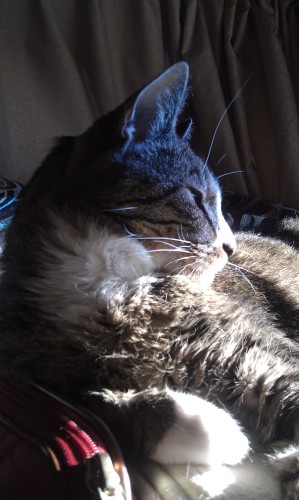
Lazlo
I have to laugh as I start to write this. First of all, I’m sure I drove the founder of CatCentric, Tracy Dion, completely insane when my journey began. YET, despite my extreme resistance, she (and the other raw feeders involved in these discussions and debates) always maintained her temper and composure. Externally, LOL. I expect there was a lot of internal screaming going on at the time (and later we became very close friends!).
And then there is the other reason I giggle, even though this really is rather embarrassing. As a raw feeder for almost four years now, one of the biggest challenges I find people face when they consider feeding raw is the vet. Sadly, far too many veterinarians believe the fear-mongering marketed as education about how dangerous it is to feed a pet raw food. But my story is the opposite: my vet wanted my cats on raw, and I resisted. My poor kitties. They could have been eating raw at least a year earlier.
Dial-back the date to May 2010. My husband and I were actively trapping feral cats for spay/neuter and release in an established, managed colony. One cat showed up so food aggressive he scattered the entire colony in three days. Obviously we couldn’t release him after being neutered. Instead we isolated him inside while we figured out what the heck to do. His first night home, that kitty had the worst diarrhea we’d ever seen. I’ll spare you the details, but clean-up was a nightmare. I have no idea what this poor kitty went through, and despite clearly being feral, this cat was happy to be rescued. He was in a very bad way, and he knew we were helping him.
We named him Chumley. And Chumley started traditional vet treatments: antibiotics, dewormers, prescription foods; single-protein, limited ingredient diets … Here, give him this probiotic (Flortiflora). Oh, that made his diarrhea worse? Try this dewormer. That didn’t help? Try feeding him this easy-to-digest food. He’s still having problems? Well try this antibiotic instead, he’s probably got IBD. Oh – now he’s grooming obsessively? It HAS to be allergies. Allergies and IBD. Try this prescription food instead.
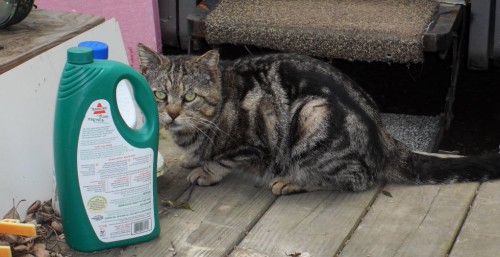
Chumley
Yes, we went for a second opinion, and got right back on the same merry-go-round. Same treatments, same foods were suggested.
Six months later, we’d finally had it. The vets had us trying effectively the same things over and over, yet expecting different results. We – and poor Chumley – could take no more. We needed to start thinking outside the box, because the box had us trapped with a suffering kitty cat.
What about a holistic vet??? I knew nothing about it really but at this point, what could be the harm in trying? It’s not like it could get any worse for Chumley. (And through it all he had such a happy grateful spirit!) I searched the American Holistic Veterinary Medical Association to see if there was a vet we could get to, trained in more than just western medicine that might help. YES! I found one about an hour away from us. She is a D.V.M. and additionally trained in Chinese Medicine, herbs, acupuncture, western herbs, feline nutrition – a potential goldmine of information that may help our cat!
At our appointment, the first thing the vet asked of us was to review his diet. “Chumley is on the allergen-free prescription kibble and canned food, Hill’s z/d.”
The new vet on our team is blunt and an alarmist. “Well, no wonder the poor thing is so sick! You MUST stop feeding kibble IMMEDIATELY. You have to get ALL of your cats off kibble, there is NO WORSE FOOD for a cat. These animals are obligate carnivores. You can do your own work on it, you like to research, but cats need a meat-based diet.” Yeah, that was humiliating.
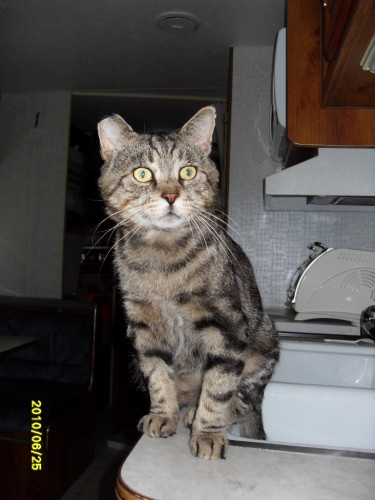
The handsome Chumley.
(Knowing what I do now, I think shocking my cats into a wet food-only diet and timed meals was a HUGE mistake. We all stressed that transition, and it should have been done gradually and slowly. But I was under the impression this was an urgent imperative in Chumley’s health. Cats that had nibbled on kibble all day for almost 10 years were transitioned to timed, wet-food only scheduled meals inside of about three weeks. I have since told the vet that she should remove the SHOCK CONTENT of her message, because that was too hard on them, me, and completely unnecessary! The road to better health is not a race, it is a journey).
Bottom-line? She wanted Chumley on a “species-appropriate” diet with proper probiotics (human grade, and much higher doses than available in most pet probiotics) and a few other healing components. The last thing the vet said in that part of our discussion was, “Once he’s stable, I want him on a raw food diet.” “Even though he’s FIV+ ?” Her answer: “Yes, that makes it even more imperative he eat healthy food!”
Well my husband and I were focused on Trap-Neuter-Return and advocacy. Feline diet was not an area of interest, and something we knew zip about. We fed what the (traditional) vets suggested without considering it might not be the best food for our cats. So I started reading. And learning. And hoo boy, if you want to be scared about feeding a raw diet, you can find plenty of “research” to support that.
I became heavily involved in feline nutrition debates online. And I argued AGAINST feeding raw. I was good at finding sources to back up my stance on it. Common sense had nothing to do with it, I wanted SCIENCE. The raw feeders couldn’t point to one study and say “these cats were fed raw food and X, Y, and Z happened vs. these cats eating canned or kibble.” (Actually, one study in cats did exist [and there are more now]. The problem is that UC Davis had the hubris to try identify a “gold standard natural diet” as being a single protein, raw ground food without supplements. A single-protein ground diet without supplements is something no raw feeder with even half a clue would ever recommend. Tragically, one of the cats in the study died from a taurine deficiency. That’s rather distracting to the overall results reported, which otherwise did find a number of qualitative benefits to feeding a raw diet).
Now it’s eight months later. The cats are all transitioned to wet-food only, fed in timed meals. The holistic vet is happy, Chumley is cured of his over-grooming and gastrointestinal problems. And while not raw, my cats are at least eating species-appropriate food (meat-based, high protein, low carb canned foods). I’m feeding expensive stuff, and with eight cats, we’re investing a LOT of money in cat food.
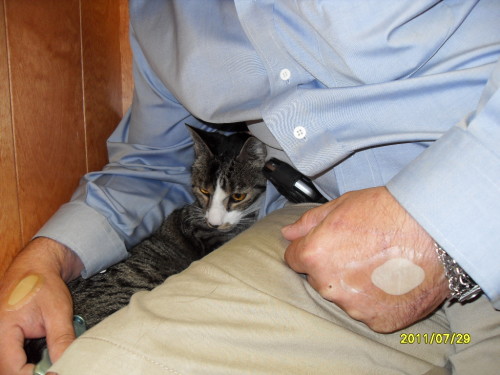
Lazlo, taking comfort from his “dad”.
I head off to the holistic vet with Lazlo, our very first cat. He’s been acting strange and throwing up HUGE hairballs. (But cats do that, right? I’ve since learned no, they shouldn’t be tossing hairballs). His appetite is off (probably the hairballs). He’s losing weight, though I’m pretty sure that’s due to the diet change and the switch to timed meals. But I’d like to make sure there’s nothing else going on with him.
We get that punch-in-the-gut kind of news that makes everything start buzzing. There is a massive mass in his stomach. Without further information, Doc doesn’t want to say it’s cancer, but yeah, it’s probably cancer. Bzzzzzzzzzzzzzzzzzzzzzzzzz. It turns out that huge mass is lymphoma. Large cell lymphoma. If we don’t treat it, he likely has about four weeks to live. We get an emergency appointment at the recommended oncologist the morning after we get the biopsy results. We begin Lazlo’s chemotherapy that day. And I start looking for the best way to support him through this process.
Thanks to a turn in one of the feline nutrition related discussions at that time, my attention was drawn to what goes into cat food. This was a completely different approach than focusing on the problems with feeding raw food. I experienced another punch-in-the-gut moment, and my world turned upside down yet again. What I learned both shocked and disappointed me. More than anything, my initial reaction was an overwhelming sadness, and I literally cried. I wasn’t sure what I’d been feeding my cats even qualified as food.
What changed? What flipped my switch? Forget what actually gets used in cat (and dog) food. I stopped thinking about the food in terms of what my cats eat, and started thinking of it in terms of what I eat. I served up their food and thought – is that what I’d want to live on, day-in, day-out? Waste meat and organ product, cooked and processed to death? Would I want to live on dry cereal and canned stew? Forever? How would I feel if I never ate another bite of fresh food – EVER? No apple, no salad – never, ever?
But how could I possibly afford to feed eight cats raw food???? Most of the blog posts and newspaper articles on it talk about how expensive it is to feed. I had to run the numbers (being a chartered financial analyst and all). OHMYGOODNESS. It will cost me LESS to feed them raw food!!!!! I will save at least $100 a month, probably more. Hubby was immediately on board.
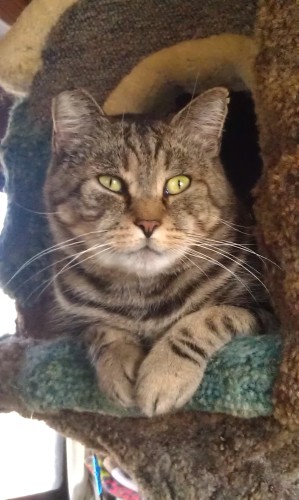
Chumley
I was nervous. I was scared. And they didn’t like it. I had to work at getting them to accept it. But I had a cat with cancer, and I NEEDED him to have the best possible chance to beat it and stay in remission. Yes, we transitioned to raw while Lazlo was in chemotherapy and on immune-suppressive doses of steroids. And with ALL of our vets’ knowledge. Our transition to raw is a different story for another time. But as I type this, four years and four months after Lazlo was given four weeks to live, Lazlo just finished eating his morning meal of raw beef, licking the bowl clean. Sadly, there are lingering effects from having eaten such a poor diet for the first 10 years of his life. His three siblings experience those as well. Sometimes the switch to a better diet highlights the problems we couldn’t see before. But at least now I am aware of the GI motility problems those prescription foods created (they were on prescription Hill’s c/d for seven years after three of the boys blocked from crystals). Aware of the problem since transitioning to homemade raw food, I can now manage it.
I don’t know that raw, fresh, human grade food alone is keeping Lazlo in remission (knock wood). But one thing I know for sure? Fresh, human grade food, properly prepared and balanced for an obligate carnivore (meaning what he eats is only animal-based) is giving his body the best fighting chance there is to stay as healthy as possible as long as possible. And Chumley? One of my FIV+ cats? (Yes, we’ve added three more, and they all eat raw, too). Well, you can see the change in him in these pictures. He is absolutely thriving. At 8 or 9 years old, he is one of my healthiest seniors. Of course I’m a raw food advocate, but I’m not picky. Cook it if you’re scared. I don’t care, just feed your cat real food (properly balanced, of course!). They deserve fresh food, too. Just like us, they thrive on a minimally processed diet. They are worth the effort!
If you feed a home-prepared raw menu to your kitties and would like to see your story featured here, please contact us via private message through Facebook on our page or in our group or leave a comment below!
And if you’re interested in giving raw a try for yourself, check out our Raw Feeding and Transitioning Your Cat to Raw sections!
If you enjoyed this post or found it informative, please “Like” it, “Tweet” it, or share it using any of the buttons below. And don’t forget to check out our FB page, join the discussions in our awesome FB group and follow us on Twitter!


Comments
My Journey to Raw: Would I want to eat that? — No Comments